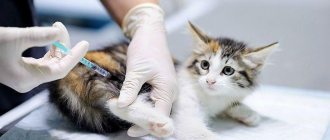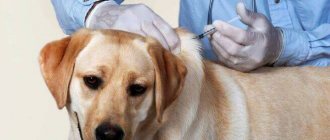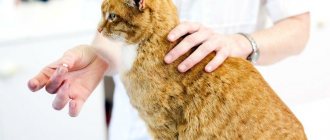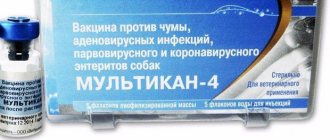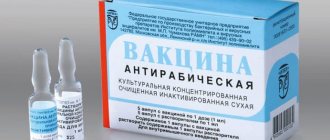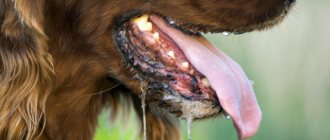Rabies vaccination for animals
must be carried out. According to the law, animals that have reached three months of age must be vaccinated against this viral disease. In nature, the main carriers of the disease are foxes, raccoons, raccoon dogs, wolves and rats.
Rabies is incurable in animals and humans and leads to 100% death of those affected. Infection occurs when a sick animal is bitten or its saliva gets on injured areas of the skin or mucous membranes. Only timely vaccination can prevent the occurrence of rabies in cats and dogs, even when they have had contact with a carrier of the disease. By law, the owner is required to vaccinate his pet annually. In its absence, you will need to pay a fine. The animal can also be quarantined if there are doubts about its health. In exceptional cases, it is possible to kill it and send brain tissue for laboratory tests to detect rabies.
In the absence of vaccination, cats and dogs are not allowed for exhibitions, breeding and transportation in public transport.
When asked whether you should get a rabies vaccination
, there is only one answer - necessary.
Contraindications to rabies vaccination
Temporary contraindications to rabies immunization are:
- animal pregnancy;
- feeding offspring;
- age less than 2 months;
- recovery period after illness.
In other cases, there are no restrictions on the procedure.
Vaccination of cats against rabies
Cats are vaccinated annually. Complex vaccines are used for it, which allow you to simultaneously protect the animal not only from rabies, but also from a number of major diseases; or monovaccines, only against this virus. The second option is preferable for older animals who should not overload their body.
The vaccination is given only to a completely healthy cat, which has been treated for worms and fleas 2 weeks before the administration of the drug. Depending on the type of vaccine, it is administered subcutaneously or intramuscularly. If a vaccination is chosen using vaccines from different manufacturers, then the injections are given in different places so that the drugs do not overlap. Some manufacturers make it possible to combine the rabies vaccine they produce with one that will protect the animal from major diseases. In this case, the rabies composition acts as a diluent for the second component of the vaccine. Most often, Nobivak formulations are used in this way.
Revaccination should be carried out annually. An exception is Nobivac Rabies serum, which provides immunization for a period of 3 years. However, if it is necessary to obtain documents from state veterinary services, they will not look at this and will require revaccination annually.
In addition to Nobivak vaccines, the following products are also used:
- Rabikan,
- Quadricate,
- Felovax.
Imported vaccines are more easily tolerated by animals than Russian ones.
Vaccination of dogs against rabies
According to the law, a dog must be vaccinated against rabies annually starting from the age of three months, i.e. still a puppy. Vaccination of a puppy begins only after examination by a veterinarian and then only under his direct supervision. Information about vaccination is entered into the animal’s veterinary passport and is confirmation that the animal is protected from the disease and cannot be its carrier.
More often, rabies is vaccinated in combination with other major diseases. It is especially important to accurately monitor compliance with the vaccination schedule for hunting dog breeds that are used strictly for their intended purpose and regularly come into contact with wild animals. They have a much higher risk of contracting rabies than other pets.
When a vaccine is administered, there is no risk that diseases will begin to develop, but at the same time, stable immunity is formed. The risk that a vaccinated dog will develop rabies is less than 1%. This phenomenon can only be observed if the vaccination was carried out with a low-quality vaccine, or if the pet was sick at the time of the injection.
Rabies vaccination for a dog
injected subcutaneously in the withers area. Certain types of vaccine can be given intramuscularly in the thigh. Animals tolerate immunization against rabies easily, only in rare cases there is a deterioration in health that lasts 2-3 days. A complication may also be the appearance of a lump under the skin, which resolves within 10-30 days. It may appear due to the individual reaction of the animal’s body or due to too rapid administration of the drug.
Video
More photos Author(s):
A.L.
Elakov, Ph.D., senior researcher Organization(s):
Federal State Budgetary Institution “Research Institute of Virology named after.
DI. Ivanovsky" Ministry of Health of Russia, Moscow Journal:
No. 4 - 2013 UDC.619:578.824.11:615.317
annotation
Prevention of rabies in domestic and farm animals is based on their immunization using mono- and associated vaccines. The article describes domestic and foreign rabies vaccines used in Russia.
Summary
The prevention of rabies at domestic and agricultural animals based on their immunization by of mono—and the associated vaccines. In the article the domestic and agricultural animals rabies vaccines applied in Russia are described.
Among infectious diseases of humans and animals, rabies occupies a special place, which, despite many years of study, remains practically incurable. Some sensational cases of recovery of people with rabies leave hope that progress in this area will still be achieved. However, modern realities are such that the main role in the fight against this infection today is played by the prevention of disease in susceptible animals, especially carnivores, capable of further transmission of the pathogen.
Analysis of the epizootic situation shows that in Russia there are persistent natural foci of the disease, maintained primarily by wild carnivores (fox, raccoon dog, etc.), which are the main reservoir and source of the rabies virus. Dogs and cats are also involved in the epizootic process, which requires increased attention in light of their close proximity to humans [3]. The basis for the prevention of rabies in domestic animals is their immunization using mono- and associated vaccines.
The development of rabies vaccines dates back to the 19th century, when Louis Pasteur first demonstrated the ability to protect dogs from forced infection with rabies [5]. Since then, a large number of different veterinary rabies vaccines (brain, embryonic, cultural, etc.) have been developed and tested for practical use. Improving production technology leads to the abandonment of outdated samples in favor of more advanced and higher quality drugs.
Currently, for the prevention of rabies in domestic and farm animals in Russia, inactivated cultural rabies vaccines from fixed strains of the rabies virus are registered, produced and used: Shchelkovo-51, TS-80, Vnukovo-32, ERA-SV20M.
The Shchelkovo-51 strain was obtained by adapting the “Ovechiy-VGNKI” strain (a variant of the Pasteur strain) to a continuous culture of Syrian hamster kidney cells VNK-21/13 [4].
From the Shchelkovo-51 strain, the Shchelkovo Biocombine (Moscow Region, Biokombinat village) produces: inactivated dry culture rabies vaccine from the “Shchelkovo-51” strain for dogs and cats (Rabikan), inactivated liquid culture rabies vaccine from the “Shchelkovo-51” strain ( Rabikov) and inactivated dry culture rabies vaccine from the Shchelkovo-51 strain. All these drugs contain the rabies virus inactivated by β-propiolactone and are intended for preventive and forced immunization of domestic animals: Rabikan - for dogs and cats, Rabikov - for cattle and small ruminants and horses, inactivated dry culture rabies vaccine from the Shchelkovo-51 strain – for all types of animals. The inactivated dry culture rabies vaccine from the Shchelkovo-51 strain can be supplied complete with a solvent (RCAV) containing saponin and intended to increase the immunogenicity of this vaccine only in large and small ruminants. Today, the Federal State Unitary Enterprise "Shchelkovo Biocombine" is the largest manufacturer of anti-rabies vaccine in the Russian Federation (about 10 million doses).
The Vnukovo-32 and ERA strains are derivatives of the SAD (State Alabama Dufftring) strain, which was isolated in the USA from a rabid dog and underwent 130 consecutive passages through the brain of mice and 25 alternating passages through the mouse brain and Syrian hamster kidney cells.
The ERA strain was obtained from the SAD strain by carrying out 10 passages on developing chicken embryos and 30 passages in a pig embryonic kidney cell culture [5]. The ERA strain was adapted to the BHK21 cell culture and, after 20 consecutive passages, was named ERA-CB20M [2].
From the ERA-CB20M strain of rabies virus inactivated by β-propiolactone and sorbed on aluminum hydroxide, Vetbiohim CJSC (Moscow) produces the following vaccines:
1. Multikan-8 – vaccine against distemper, adenovirus infections, parvovirus, coronavirus enteritis, leptospirosis and rabies in dogs.
2. ASTERION DHPPiR - vaccine against distemper, adenovirus infections, parvovirus enteritis, parainfluenza and rabies in dogs.
3. ASTERION DHPPiLR – vaccine against distemper, adenovirus infections, parvovirus enteritis, parainfluenza, leptospirosis and rabies in dogs.
The annual volume of produced vaccines containing an anti-rabies component does not exceed 200 thousand doses.
The Vukovo-32 strain was also obtained from the ERA strain by carrying out 10 passages in a primary culture of Syrian hamster kidney cells (SHR) at 37°C and 163 passages in SHR at a temperature of 32°C [6].
From the Vnukovo-32 strain reproduced in a primary or continuous culture of Syrian hamster cells, inactivated by ultraviolet rays and lyophilized in a special protective environment, Vetzverocentre CJSC (Moscow) produces the rabies component of an associated vaccine against rabies, canine distemper, parvovirus enteritis, infectious hepatitis, adenovirosis and leptospirosis of dogs (Dipentavak)), intended for immunization of dogs. The annual volume of rabies vaccine produced does not exceed 100 thousand doses.
Strain TC-80 was obtained from strain V-319, isolated from the salivary gland of a bat in Mexico, by adaptation to a continuous culture of BHK-21 cells. It went through 10 passages in the BHK-21 cell culture, and then over 70 passages in a continuous culture of saiga kidney cells (SB), after which it was taken as the basis for the construction of an inactivated vaccine against animal rabies [1].
From the TS-80 strain, VNIIVViM (Volginsky village, Vladimir region) produces an anti-rabies vaccine, inactivated culture-sorbed liquid, containing the rabies virus reproduced in PS cell culture, inactivated by theotropin, sorbed on aluminum hydroxide, and is intended for immunization of large and small livestock, dogs and cats. The annual production volume of this vaccine does not exceed 1 million doses.
In addition to domestic vaccines, the following foreign drugs containing a rabies component are registered and used in our country:
- Preparations produced by Merial (France): Rabizin, Quadrikat, Eurican DHPPI2-LR, Hexadog, containing β-propiolactone-inactivated strain GS-57 of the rabies virus, sorbed on aluminum hydroxide. The Rabizin vaccine is intended for immunization of agricultural, domestic and wild animals against rabies. Associated vaccines Quadricat and Eurikan DHPPI2-LR, Hexadog are intended, respectively, the first for cats, the other two for dogs, and contain an inactivated rabies virus as part of the liquid component.
- Nobivak-RL and Nobivak-Rabies produced (Netherlands) contain β-propiolactone-inactivated rabies virus strain Pasteur/RIV, sorbed on aluminum phosphate. The Nobivak-RL vaccine is intended for immunization of dogs, and Nobivak-Rabies is intended for dogs and cats, and can serve as solvents for a group of vaccines produced by this company.
- The Defensor-3 vaccine produced by Pfizer (USA) is intended for the prevention of rabies in cattle, sheep, dogs and cats; it contains β-propiolactone-inactivated rabies virus strain PV-Paris, sorbed on aluminum hydroxide.
- The Rabvac 3TF vaccine produced by Fort Dodge Animal Health (USA) is intended for immunization of dogs and cats; it contains β-propiolactone-inactivated rabies virus strain HCP-SAD and 0.1% carbopol 941 as an adjuvant.
- Vaccines Biofel PCRH, Biokan R, Biokan LR, Biokan DHPPi+LR produced by Bioveta (Czech Republic) contain as a rabic component inactivated β-propiolactone rabies virus strain Vnukovo-32, sorbed on aluminum hydroxide, and are intended for immunization of cats (Biofel PCRH) and dogs (Biocan R, Biocan LR and Biocan DHPPi+LR).
All of the above inactivated vaccines, both domestic and foreign, regularly undergo certification tests at the Federal State Institution VGNKI, are safe to use and cause lasting immunity to rabies infection, which allows them to be successfully used in the Russian Federation.
Despite such a variety of anti-rabies vaccines for animals, the situation with rabies in Russia remains tense, which is due to a number of circumstances: insufficient control over the number of wild carnivores, stray dogs and cats; poor awareness and responsibility of animal owners in terms of the care and well-being of their pets; lack of the necessary legislative framework in the field of keeping pets. To correct the situation, coordinated work of the veterinary service with legislative and executive authorities, municipal and sanitary-epidemiological services, medical institutions and supervisory authorities is required.
Literature
1. Vishnyakov I.F., Nikishin I.V., Nedosekov V.V., Gorshkova T.F., Zhesterev V.I., Shevchenko A.A., Zuev V.V., Gruzdev K.N. Inactivated cultural vaccine against animal rabies // Veterinary medicine. - 1998.- No. 6. - P.76-80.
2. Gribencha S.V., Losich M.A., Gribencha L.F., Nepoklonova I.V. A new principle for the selection of a vaccine virus based on the quantitative level of expression of the G-protein - the main immunogen of the rabies virus // Questions of Virology. - 2012.-T.57, No. 3.-P.44-47.
3. Elakov A.L., Semenova M.A., Rozanova I.I. Cases of rabies in Moscow in 2000-2010.// Materials of the International Scientific and Practical Conference “Veterinary Medicine of the 21st Century: Innovations, Experience, Problems and Solutions”, dedicated to the World Veterinary Year in commemoration of the 250th anniversary of the veterinary profession, 8- June 10, 2011 - Ulyanovsk, 2011 - P. 85-88.
4. Ivanov BC Animal rabies: experimental and theoretical justification for the development, production, use of cultural inactivated vaccines and new approaches to the problem of emergency protection of the central nervous system from the causative agent of the disease: Abstract. diss. doc. vet. Sci. - Shchelkovo, 2001. - 60 p.
5. Selimov M.A. Rabies - M.: Medicine, 1978. - 336 p.
